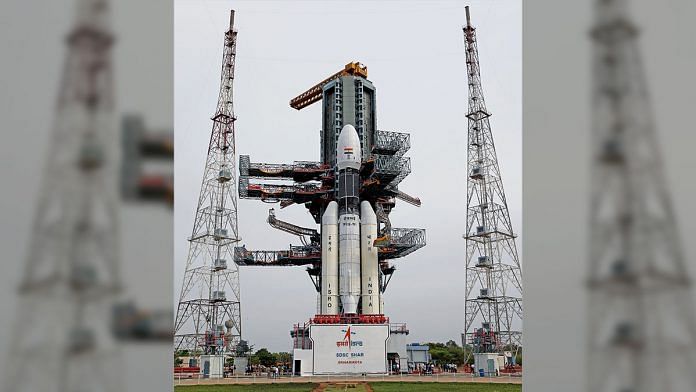Bengaluru: The Indian Space Research Organisation (ISRO) is set to launch the country’s second moon mission, Chandrayaan-2, Monday at 2.43 pm from Sriharikota, seven days after the spacecraft’s original launch was called off.
The spacecraft will be launched aboard GSLV-MkIII, India’s most powerful rocket. The official countdown began at 6.43 pm Sunday.
There is palpable tension among ISRO scientists and engineers before the launch, reported the Times of India.
The original launch was called off on 15 July, less than an hour before the rocket was due to take off, because of a pressure leak in the indigenous cryogenic stage.
“It took us more than a day to do that (corrective measures) after the glitch was discovered leading to the cancellation,” ISRO chairman K. Sivan told reporters Saturday.
“I can assure you that there will be no such technical snag this time.”
Follow live updates of the launch here
How will the craft work?
Chandrayaan-2 has three components — an orbiter, a lander, and a rover. The lander, Vikram, is named after Vikram Sarabhai, the ‘father of Indian space programme’. The rover, housed inside the lander, is called ‘Pragyaan’, meaning ‘knowledge’ in Sanskrit.
The lander is expected to touchdown on the lunar surface on 7 September. The landing site is 70.9 S, 22.7 E between the Manzinus C and Simpelius N craters. This puts the lander in Earth’s direct line of sight. Thus, it will communicate directly with the ground here, as will the orbiter. The rover is expected to send data through the lander.
The orbiter, lander and rover have eight, four and two payloads, respectively. These payloads are expected to analyse the water on the lunar surface, monitor lunar quakes, dig and study minerals and more. All the payloads are Indian, except for one American payload on the lander, operated by NASA.
The lander and rover are expected to function for 14 Earth days before frying up due to intense radiation from the sun. The orbiter is expected to function for at least a year.
Also read: India’s Chandrayaan-2 matters, but don’t dream about moon picnics with friends just as yet
Mission profile
The GSLV Mk-III is India’s most powerful launcher, capable of carrying 8,000 kg to low-earth orbit and 4,000 kg to geosynchronous transfer orbits. It consists of S200 solid rocket boosters, L110 liquid stage, and the C25 upper cryogenic stage. The development of this rocket has cost India over Rs 300 crore.
The upper stage of the rocket will drop off the 2,379 kg Chandrayaan-2 spacecraft into an eccentric orbit of 178 x 38,000 km. The craft will then perform five orbit-raising manoeuvres around Earth over the course of 16 days using the orbiter’s propellant.
When at a height of 150 x 1,41,000 km, the spacecraft will perform translunar burn and shoot towards the moon, coasting for five days and covering a distance of 3.85 lakh km.
Once it reaches near the moon, Chandrayaan-2 will fire again and perform a retro burn to brake against the lunar gravity. It will first enter an orbit of 150 x 18,000 km around the moon with an orbital period of 28 hours.
The spacecraft will then perform four orbit-lowering burns to bring itself into a 100-km circular orbit. Once in this stable orbit, the lander will separate from the orbiter and move into a 30 x 100 km orbit, where it will be parked for four days during which ISRO will perform checks on it.
On 7 September, the lander will make a controlled descent for 17 minutes on to the lunar surface. Once it lands safely, the lander will promptly open the hatch for the rover. The rover wheels sport symbols: the Ashoka Chakra on one side and ISRO’s logo on the other.
The process of landing and the subsequent release of the rover are expected to take approximately four hours.
Monday’s launch can be watched live on ISRO’s social media accounts or national broadcaster Doordarshan’s live stream.
Also read: As India prepares for another Moon mission, here is what makes Chandrayaan-2 special



